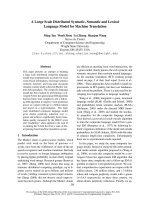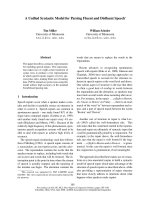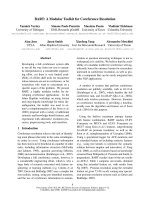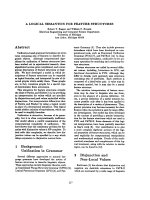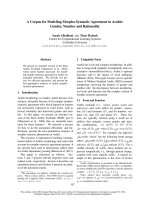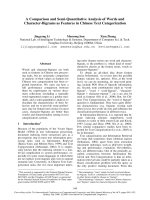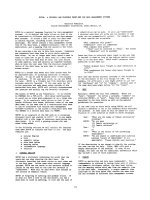Báo cáo khoa học: "A Syntactic and Lexical-Based Discourse Segmenter" pdf
Bạn đang xem bản rút gọn của tài liệu. Xem và tải ngay bản đầy đủ của tài liệu tại đây (172.86 KB, 4 trang )
Proceedings of the ACL-IJCNLP 2009 Conference Short Papers, pages 77–80,
Suntec, Singapore, 4 August 2009.
c
2009 ACL and AFNLP
A Syntactic and Lexical-Based Discourse Segmenter
Milan Tofiloski
School of Computing Science
Simon Fraser University
Burnaby, BC, Canada
Julian Brooke
Department of Linguistics
Simon Fraser University
Burnaby, BC, Canada
Maite Taboada
Department of Linguistics
Simon Fraser University
Burnaby, BC, Canada
Abstract
We present a syntactic and lexically based
discourse segmenter (SLSeg) that is de-
signed to avoid the common problem of
over-segmenting text. Segmentation is the
first step in a discourse parser, a system
that constructs discourse trees from el-
ementary discourse units. We compare
SLSeg to a probabilistic segmenter, show-
ing that a conservative approach increases
precision at the expense of recall, while re-
taining a high F-score across both formal
and informal texts.
1 Introduction
∗
Discourse segmentation is the process of de-
composing discourse into elementary discourse
units (EDUs), which may be simple sentences or
clauses in a complex sentence, and from which
discourse trees are constructed. In this sense, we
are performing low-level discourse segmentation,
as opposed to segmenting text into chunks or top-
ics (e.g., Passonneau and Litman (1997)). Since
segmentation is the first stage of discourse parsing,
quality discourse segments are critical to build-
ing quality discourse representations (Soricut and
Marcu, 2003). Our objective is to construct a dis-
course segmenter that is robust in handling both
formal (newswire) and informal (online reviews)
texts, while minimizing the insertion of incorrect
discourse boundaries. Robustness is achieved by
constructing discourse segments in a principled
way using syntactic and lexical information.
Our approach employs a set of rules for insert-
ing segment boundaries based on the syntax of
each sentence. The segment boundaries are then
further refined by using lexical information that
∗
This work was supported by an NSERC Discovery Grant
(261104-2008) to Maite Taboada. We thank Angela Cooper
and Morgan Mameni for their help with the reliability study.
takes into consideration lexical cues, including
multi-word expressions. We also identify clauses
that are parsed as discourse segments, but are not
in fact independent discourse units, and join them
to the matrix clause.
Most parsers can break down a sentence into
constituent clauses, approaching the type of out-
put that we need as input to a discourse parser.
The segments produced by a parser, however, are
too fine-grained for discourse purposes, breaking
off complement and other clauses that are not in a
discourse relation to any other segment. For this
reason, we have implemented our own segmenter,
utilizing the output of a standard parser. The pur-
pose of this paper is to describe our syntactic and
lexical-based segmenter (SLSeg), demonstrate its
performance against state-of-the-art systems, and
make it available to the wider community.
2 Related Work
Soricut and Marcu (2003) construct a statistical
discourse segmenter as part of their sentence-level
discourse parser (SPADE), the only implemen-
tation available for our comparison. SPADE is
trained on the RST Discourse Treebank (Carlson
et al., 2002). The probabilities for segment bound-
ary insertion are learned using lexical and syntac-
tic features. Subba and Di Eugenio (2007) use
neural networks trained on RST-DT for discourse
segmentation. They obtain an F-score of 84.41%
(86.07% using a perfect parse), whereas SPADE
achieved 83.1% and 84.7% respectively.
Thanh et al. (2004) construct a rule-based
segmenter, employing manually annotated parses
from the Penn Treebank. Our approach is con-
ceptually similar, but we are only concerned with
established discourse relations, i.e., we avoid po-
tential same-unit relations by preserving NP con-
stituency.
77
3 Principles For Discourse Segmentation
Our primary concern is to capture interesting dis-
course relations, rather than all possible relations,
i.e., capturing more specific relations such as Con-
dition, Evidence or Purpose, rather than more gen-
eral and less informative relations such as Elabo-
ration or Joint, as defined in Rhetorical Structure
Theory (Mann and Thompson, 1988). By having a
stricter definition of an elementary discourse unit
(EDU), this approach increases precision at the ex-
pense of recall.
Grammatical units that are candidates for dis-
course segments are clauses and sentences. Our
basic principles for discourse segmentation follow
the proposals in RST as to what a minimal unit
of text is. Many of our differences with Carl-
son and Marcu (2001), who defined EDUs for the
RST Discourse Treebank (Carlson et al., 2002),
are due to the fact that we adhere closer to the orig-
inal RST proposals (Mann and Thompson, 1988),
which defined as ‘spans’ adjunct clauses, rather
than complement (subject and object) clauses. In
particular, we propose that complements of at-
tributive and cognitive verbs (He said (that) , I
think (that) ) are not EDUs. We preserve con-
sistency by not breaking at direct speech (“X,” he
said.). Reported and direct speech are certainly
important in discourse (Prasad et al., 2006); we do
not believe, however, that they enter discourse re-
lations of the type that RST attempts to capture.
In general, adjunct, but not complement clauses
are discourse units. We require all discourse seg-
ments to contain a verb. Whenever a discourse
boundary is inserted, the two newly created seg-
ments must each contain a verb. We segment coor-
dinated clauses (but not coordinated VPs), adjunct
clauses with either finite or non-finite verbs, and
non-restrictive relative clauses (marked by com-
mas). In all cases, the choice is motivated by
whether a discourse relation could hold between
the resulting segments.
4 Implementation
The core of the implementation involves the con-
struction of 12 syntactically-based segmentation
rules, along with a few lexical rules involving a list
of stop phrases, discourse cue phrases and word-
level parts of speech (POS) tags. First, paragraph
boundaries and sentence boundaries using NIST’s
sentence segmenter
1
are inserted. Second, a sta-
tistical parser applies POS tags and the sentence’s
syntactic tree is constructed. Our syntactic rules
are executed at this stage. Finally, lexical rules,
as well as rules that consider the parts-of-speech
for individual words, are applied. Segment bound-
aries are removed from phrases with a syntactic
structure resembling independent clauses that ac-
tually are used idiomatically, such as as it stands
or if you will. A list of phrasal discourse cues
(e.g., as soon as, in order to) are used to insert
boundaries not derivable from the parser’s output
(phrases that begin with in order to are tagged as
PP rather than SBAR). Segmentation is also per-
formed within parentheticals (marked by paren-
theses or hyphens).
5 Data and Evaluation
5.1 Data
The gold standard test set consists of 9 human-
annotated texts. The 9 documents include 3 texts
from the RST literature
2
, 3 online product reviews
from Epinions.com, and 3 Wall Street Journal ar-
ticles taken from the Penn Treebank. The texts av-
erage 21.2 sentences, with the longest text having
43 sentences and the shortest having 6 sentences,
for a total of 191 sentences and 340 discourse seg-
ments in the 9 gold-standard texts.
The texts were segmented by one of the au-
thors following guidelines that were established
from the project’s beginning and was used as the
gold standard. The annotator was not directly in-
volved in the coding of the segmenter. To ensure
the guidelines followed clear and sound principles,
a reliability study was performed. The guidelines
were given to two annotators, both graduate stu-
dents in Linguistics, that had no direct knowledge
of the project. They were asked to segment the 9
texts used in the evaluation.
Inter-annotator agreement across all three anno-
tators using Kappa was .85, showing a high level
of agreement. Using F-score, average agreement
of the two annotators against the gold standard was
also high at .86. The few disagreements were pri-
marily due to a lack of full understanding of the
guidelines (e.g., the guidelines specify to break ad-
junct clauses when they contain a verb, but one
of the annotators segmented prepositional phrases
1
/>duc2003.breakSent.tar.gz
2
Available from the RST website />78
Epinions Treebank Original RST Combined Total
System P R F P R F P R F P R F
Baseline .22 .70 .33 .27 .89 .41 .26 .90 .41 .25 .80 .38
SPADE (coarse) .59 .66 .63 .63 1.0 .77 .64 .76 .69 .61 .79 .69
SPADE (original) .36 .67 .46 .37 1.0 .54 .38 .76 .50 .37 .77 .50
Sundance .54 .56 .55 .53 .67 .59 .71 .47 .57 .56 .58 .57
SLSeg (Charniak) .97 .66 .79 .89 .86 .87 .94 .76 .84 .93 .74 .83
SLSeg (Stanford) .82 .74 .77 .82 .86 .84 .88 .71 .79 .83 .77 .80
Table 1: Comparison of segmenters
that had a similar function to a full clause). With
high inter-annotator agreement (and with any dis-
agreements and errors resolved), we proceeded to
use the co-author’s segmentations as the gold stan-
dard.
5.2 Evaluation
The evaluation uses standard precision, recall and
F-score to compute correctly inserted segment
boundaries (we do not consider sentence bound-
aries since that would inflate the scores). Precision
is the number of boundaries in agreement with the
gold standard. Recall is the total number of bound-
aries correct in the system’s output divided by the
number of total boundaries in the gold standard.
We compare the output of SLSeg to SPADE.
Since SPADE is trained on RST-DT, it inserts seg-
ment boundaries that are different from what our
annotation guidelines prescribe. To provide a fair
comparison, we implement a coarse version of
SPADE where segment boundaries prescribed by
the RST-DT guidelines, but not part of our seg-
mentation guidelines, are manually removed. This
version leads to increased precision while main-
taining identical recall, thus improving F-score.
In addition to SPADE, we also used the Sun-
dance parser (Riloff and Phillips, 2004) in our
evaluation. Sundance is a shallow parser which
provides clause segmentation on top of a basic
word-tagging and phrase-chunking system. Since
Sundance clauses are also too fine-grained for our
purposes, we use a few simple rules to collapse
clauses that are unlikely to meet our definition of
EDU. The baseline segmenter in Table 1 inserts
segment boundaries before and after all instances
of S, SBAR, SQ, SINV, SBARQ from the syntac-
tic parse (text spans that represent full clauses able
to stand alone as sentential units). Finally, two
parsers are compared for their effect on segmenta-
tion quality: Charniak (Charniak, 2000) and Stan-
ford (Klein and Manning, 2003).
5.3 Qualitative Comparison
Comparing the outputs of SLSeg and SPADE on
the Epinions.com texts illustrates key differences
between the two approaches.
[Luckily we bought the extended pro-
tection plans from Lowe’s,] # [so we
are waiting] [for Whirlpool to decide]
[if they want to do the costly repair] [or
provide us with a new machine].
In this example, SLSeg inserts a single bound-
ary (#) before the word so, whereas SPADE in-
serts four boundaries (indicated by square brack-
ets). Our breaks err on the side of preserving se-
mantic coherence, e.g., the segment for Whirlpool
to decide depends crucially on the adjacent seg-
ments for its meaning. In our opinion, the rela-
tions between these segments are properly the do-
main of a semantic, but not a discourse, parser. A
clearer example that illustrates the pitfalls of fine-
grained discourse segmenting is shown in the fol-
lowing output from SPADE:
[The thing] [that caught my attention
was the fact] [that these fantasy novels
were marketed ]
Because the segments are a restrictive relative
clause and a complement clause, respectively,
SLSeg does not insert any segment boundaries.
6 Results
Results are shown in Table 1. The combined in-
formal and formal texts show SLSeg (using Char-
niak’s parser) with high precision; however, our
overall recall was lower than both SPADE and the
baseline. The performance of SLSeg on the in-
formal and formal texts is similar to our perfor-
79
mance overall: high precision, nearly identical re-
call. Our system outperforms all the other systems
in both precision and F-score, confirming our hy-
pothesis that adapting an existing system would
not provide the high-quality discourse segments
we require.
The results of using the Stanford parser as an
alternative to the Charniak parser show that the
performance of our system is parser-independent.
High F-score in the Treebank data can be at-
tributed to the parsers having been trained on Tree-
bank. Since SPADE also utilizes the Charniak
parser, the results are comparable.
Additionally, we compared SLSeg and SPADE
to the original RST segmentations of the three
RST texts taken from RST literature. Performance
was similar to that of our own annotations, with
SLSeg achieving an F-score of .79, and SPADE
attaining .38. This demonstrates that our approach
to segmentation is more consistent with the origi-
nal RST guidelines.
7 Discussion
We have shown that SLSeg, a conservative rule-
based segmenter that inserts fewer discourse
boundaries, leads to higher precision compared to
a statistical segmenter. This higher precision does
not come at the expense of a significant loss in
recall, as evidenced by a higher F-score. Unlike
statistical parsers, our system requires no training
when porting to a new domain.
All software and data are available
3
. The
discourse-related data includes: a list of clause-
like phrases that are in fact discourse markers
(e.g., if you will, mind you); a list of verbs used
in to-infinitival and if complement clauses that
should not be treated as separate discourse seg-
ments (e.g., decide in I decided to leave the car
at home); a list of unambiguous lexical cues for
segment boundary insertion; and a list of attribu-
tive/cognitive verbs (e.g., think, said) used to pre-
vent segmentation of floating attributive clauses.
Future work involves studying the robustness of
our discourse segments on other corpora, such as
formal texts from the medical domain and other
informal texts. Also to be investigated is a quan-
titative study of the effects of high-precision/low-
recall vs. low-precision/high-recall segmenters on
the construction of discourse trees. Besides its use
in automatic discourse parsing, the system could
3
/>assist manual annotators by providing a set of dis-
course segments as starting point for manual an-
notation of discourse relations.
References
Lynn Carlson and Daniel Marcu. 2001. Discourse
Tagging Reference Manual. ISI Technical Report
ISI-TR-545.
Lynn Carlson, Daniel Marcu and Mary E. Okurowski.
2002. RST Discourse Treebank. Philadelphia, PA:
Linguistic Data Consortium.
Eugene Charniak. 2000. A Maximum-Entropy In-
spired Parser. Proc. of NAACL, pp. 132–139. Seat-
tle, WA.
Barbara J. Grosz and Candace L. Sidner. 1986. At-
tention, Intentions, and the Structure of Discourse.
Computational Linguistics, 12:175–204.
Dan Klein and Christopher D. Manning. 2003. Fast
Exact Inference with a Factored Model for Natu-
ral Language Parsing. Advances in NIPS 15 (NIPS
2002), Cambridge, MA: MIT Press, pp. 3–10.
William C. Mann and Sandra A. Thompson. 1988.
Rhetorical Structure Theory: Toward a Functional
Theory of Text Organization. Text, 8:243–281.
Daniel Marcu. 2000. The Theory and Practice of
Discourse Parsing and Summarization. MIT Press,
Cambridge, MA.
Rebecca J. Passonneau and Diane J. Litman. 1997.
Discourse Segmentation by Human and Automated
Means. Computational Linguistics, 23(1):103–139.
Rashmi Prasad, Nikhil Dinesh, Alan Lee, Aravind
Joshi and Bonnie Webber. 2006. Attribution and its
Annotation in the Penn Discourse TreeBank. Traite-
ment Automatique des Langues, 47(2):43–63.
Ellen Riloff and William Phillips. 2004. An Introduc-
tion to the Sundance and AutoSlog Systems. Univer-
sity of Utah Technical Report #UUCS-04-015.
Radu Soricut and Daniel Marcu. 2003. Sentence Level
Discourse Parsing Using Syntactic and Lexical In-
formation. Proc. of HLT-NAACL, pp. 149–156. Ed-
monton, Canada.
Rajen Subba and Barbara Di Eugenio. 2007. Auto-
matic Discourse Segmentation Using Neural Net-
works. Proc. of the 11th Workshop on the Se-
mantics and Pragmatics of Dialogue, pp. 189–190.
Rovereto, Italy.
Huong Le Thanh, Geetha Abeysinghe, and Christian
Huyck. 2004. Automated Discourse Segmentation
by Syntactic Information and Cue Phrases. Proc. of
IASTED. Innsbruck, Austria.
80

